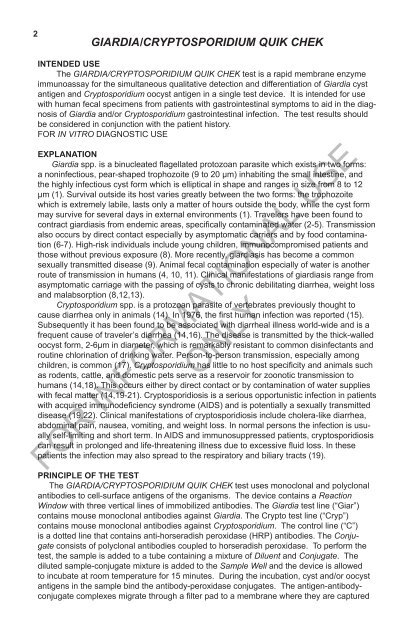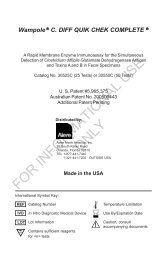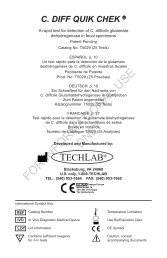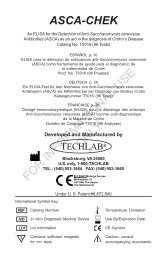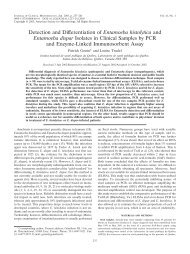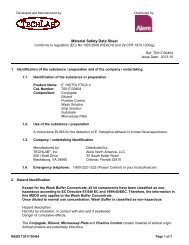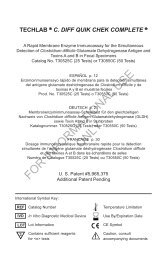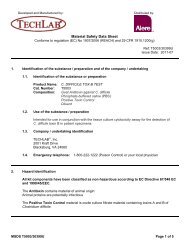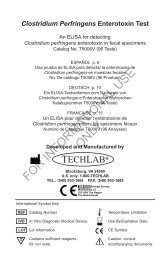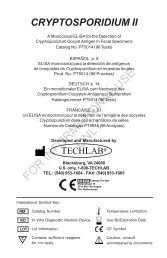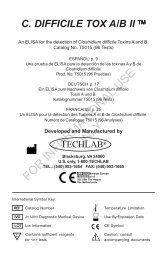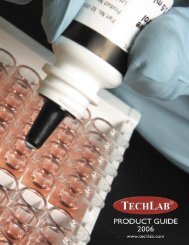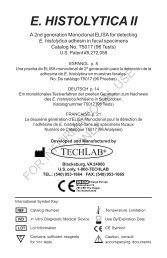GIARDIA CRYPTO QUIK CHEK insert 11-2011.indd - TechLab
GIARDIA CRYPTO QUIK CHEK insert 11-2011.indd - TechLab
GIARDIA CRYPTO QUIK CHEK insert 11-2011.indd - TechLab
You also want an ePaper? Increase the reach of your titles
YUMPU automatically turns print PDFs into web optimized ePapers that Google loves.
2<br />
<strong>GIARDIA</strong>/<strong>CRYPTO</strong>SPORIDIUM <strong>QUIK</strong> <strong>CHEK</strong><br />
INTENDED USE<br />
The <strong>GIARDIA</strong>/<strong>CRYPTO</strong>SPORIDIUM <strong>QUIK</strong> <strong>CHEK</strong> test is a rapid membrane enzyme<br />
immunoassay for the simultaneous qualitative detection and differentiation of Giardia cyst<br />
antigen and Cryptosporidium oocyst antigen in a single test device. It is intended for use<br />
with human fecal specimens from patients with gastrointestinal symptoms to aid in the diagnosis<br />
of Giardia and/or Cryptosporidium gastrointestinal infection. The test results should<br />
be considered in conjunction with the patient history.<br />
FOR IN VITRO DIAGNOSTIC USE<br />
EXPLANATION<br />
Giardia spp. is a binucleated fl agellated protozoan parasite which exists in two forms:<br />
a noninfectious, pear-shaped trophozoite (9 to 20 μm) inhabiting the small intestine, and<br />
the highly infectious cyst form which is elliptical in shape and ranges in size from 8 to 12<br />
μm (1). Survival outside its host varies greatly between the two forms: the trophozoite<br />
which is extremely labile, lasts only a matter of hours outside the body, while the cyst form<br />
may survive for several days in external environments (1). Travelers have been found to<br />
contract giardiasis from endemic areas, specifi cally contaminated water (2-5). Transmission<br />
also occurs by direct contact especially by asymptomatic carriers and by food contamination<br />
(6-7). High-risk individuals include young children, immunocompromised patients and<br />
those without previous exposure (8). More recently, giardiasis has become a common<br />
sexually transmitted disease (9). Animal fecal contamination especially of water is another<br />
route of transmission in humans (4, 10, <strong>11</strong>). Clinical manifestations of giardiasis range from<br />
asymptomatic carriage with the passing of cysts to chronic debilitating diarrhea, weight loss<br />
and malabsorption (8,12,13).<br />
Cryptosporidium spp. is a protozoan parasite of vertebrates previously thought to<br />
cause diarrhea only in animals (14). In 1976, the fi rst human infection was reported (15).<br />
Subsequently it has been found to be associated with diarrheal illness world-wide and is a<br />
frequent cause of traveler’s diarrhea (14,16). The disease is transmitted by the thick-walled<br />
oocyst form, 2-6μm in diameter, which is remarkably resistant to common disinfectants and<br />
routine chlorination of drinking water. Person-to-person transmission, especially among<br />
children, is common (17). Cryptosporidium has little to no host specifi city and animals such<br />
as rodents, cattle, and domestic pets serve as a reservoir for zoonotic transmission to<br />
humans (14,18). This occurs either by direct contact or by contamination of water supplies<br />
with fecal matter (14,19-21). Cryptosporidiosis is a serious opportunistic infection in patients<br />
with acquired immunodefi ciency syndrome (AIDS) and is potentially a sexually transmitted<br />
disease (19,22). Clinical manifestations of cryptosporidiosis include cholera-like diarrhea,<br />
abdominal pain, nausea, vomiting, and weight loss. In normal persons the infection is usually<br />
self-limiting and short term. In AIDS and immunosuppressed patients, cryptosporidiosis<br />
can result in prolonged and life-threatening illness due to excessive fl uid loss. In these<br />
patients the infection may also spread to the respiratory and biliary tracts (19).<br />
FOR INFORMATIONAL USE<br />
ONLY<br />
PRINCIPLE OF THE TEST<br />
The <strong>GIARDIA</strong>/<strong>CRYPTO</strong>SPORIDIUM <strong>QUIK</strong> <strong>CHEK</strong> test uses monoclonal and polyclonal<br />
antibodies to cell-surface antigens of the organisms. The device contains a Reaction<br />
Window with three vertical lines of immobilized antibodies. The Giardia test line (“Giar”)<br />
contains mouse monoclonal antibodies against Giardia. The Crypto test line (“Cryp”)<br />
contains mouse monoclonal antibodies against Cryptosporidium. The control line (“C”)<br />
is a dotted line that contains anti-horseradish peroxidase (HRP) antibodies. The Conjugate<br />
consists of polyclonal antibodies coupled to horseradish peroxidase. To perform the<br />
test, the sample is added to a tube containing a mixture of Diluent and Conjugate. The<br />
diluted sample-conjugate mixture is added to the Sample Well and the device is allowed<br />
to incubate at room temperature for 15 minutes. During the incubation, cyst and/or oocyst<br />
antigens in the sample bind the antibody-peroxidase conjugates. The antigen-antibodyconjugate<br />
complexes migrate through a fi lter pad to a membrane where they are captured


